Solved examples
Example 30.1 A square frame of edge 10 cm is placed with its positive normal making an angle of 600 with a uniform
electric field of 20 V/m. Find the flux of the electric field through the surface bounded by the frame.
Sol. The surface considered is plane and the electric field is uniform figure. Hence, the flux is
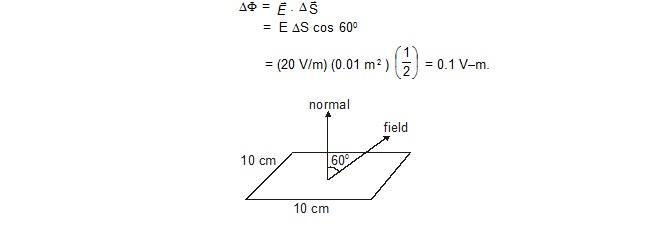
Example 30.2 A change q is placed at the centre of a sphere. Taking outward normal as positive, find the flux of
the electric field through the surface of the sphere due to the enclosed charge.
Sol.
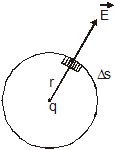
Let us take a small element DS on the surface of the sphere figure. The electiric field here is radially outward and has the magnitude

Example 30.3 A uniform electric field exists in space. Find the flux of this field through a cylindrical surface with the
axis parallel to the field.
Sol.

Consider figure and take a small area DS on the cylindrical surface. The normal to this area will be perpendicullar to
the axis of the cylinder. But the electric field is parallel to the axis and hence
Delta phi = E = E Delta S cos (p / 2) = 0.
This is true for each small part of the cylindrical surface. Summing over the entire surface, the total flux is zero.
Example 30.4 A charge Q is distributed uniformly on a ring of radius r. A sphere of equal radius r is constructed with
its centre at the periphery of the ring figure. Find the flux of the electric field through the surface of the sphere.
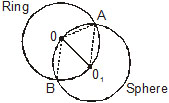

Work out Examples
1. A uniform electric field of magnitude E = 100 N/C exist in the space in X-direction. Calculate the flux of this field
through a plane square area of edge 10cm placed in the Y–Z plane. Take the normal along the positive X-axis to be positive

2. A large plane charge sheet having having surface charge density s = 2.0 × 10–6/Cm2 lies in the X-Y plane. Find the flux
of the electric field through a circular area of radius 1 cm lying completely in the region where x, y, z are all positive and
with its normal making an angle of 60º with the Z-axis.

3. A charge of 4 × 10–8 C is distributed uniformly on the surface of a sphere of radius 1 cm. It is covered by a concentric,
hollow conducting sphere of radius 5cm. (a) Find the electric field at a point 2 cm away from the centre.
(b) A charge of 6 × 10–8 C is placed on the hollow sphere. Find the surface charge density on the outer surface of the hollow sphere.

(a) Let us consider figure. Suppose, we have to find the field at the point P. Draw a concentric spherical surface through P.
All the points on this surface are equvalent and by symmetry, the field at all these points will be equal in magnitude
and redial in direction.
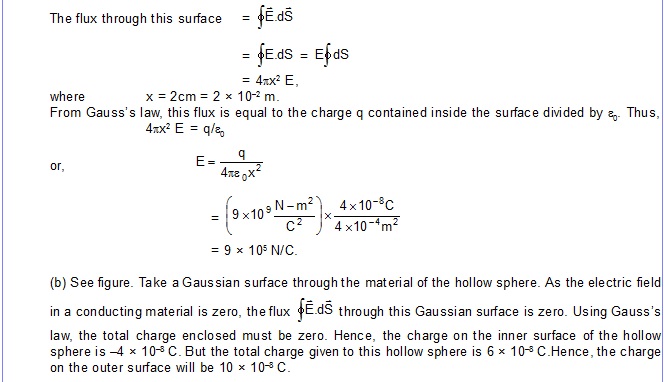
4. Figure shows three concentric thin spherical shells A, B and C of radii a, b and c respectively. The shells A and C
are given charges q and – q respectively and the shell B is earthed. Find the charged appearing on the surfaces of B and C.
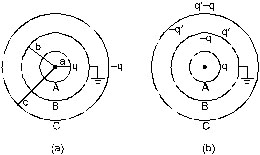
Sol. As shown in the previous worked out example, the inner surface of B must have a charge –q from the Gauss’s law.
Suppose, the outer surface of B has a charge q’. The inner surface of C must have a charge –q’ from the Gauss’s law.
As the net charge on C must be –q, its outer surface sould have a charge q’ – q. The charge distribution is shown in figure.
The potential at B due to the charge q on A

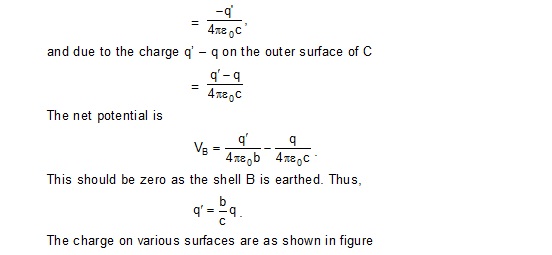
5. An electric dipole consists of charges ±2.0 × 10 8C separated by a distance of 2.0 × 10–3m. It is placed near a long line
charge of linear charge density 4.0 × 10–4 C/m as shown in figure, such that the negative charge is at a distance of 2.0
cm from the line charge. Find the force acting on the dipole.
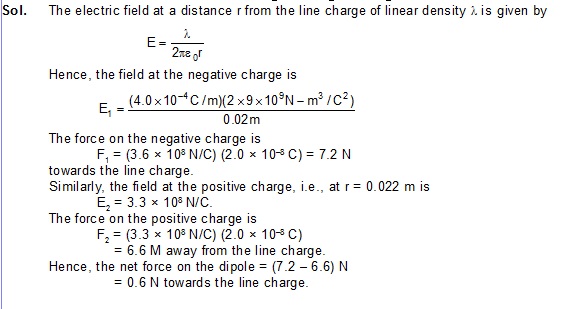
6. The electric field in a region is radially outward with magnitude E = Ar. Find the charge contained in a sphere of radius
a centred at the origin. Take A = 100 V/m2 and a = 20.0 cm.
Sol. The electric field at the surface of the sphere is Aa and being radial it is along the outward normal. flux of the electric field is, therefore,


7. A particle of mass 5 × 10–6 g is kept over a large horizontal sheet of charge of density 4.0 × 10–6 C/m2 figure. What charge
should be givento this particle so that if released, it does not fall down? How many electrons are to be removed to give this charge?
How much mass is decreased due to the removal of these electrons?
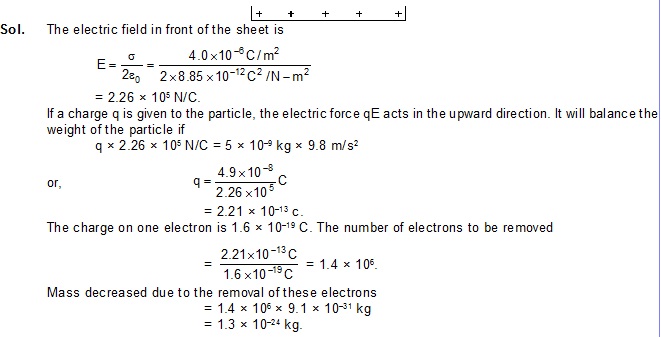
8. Two conducting plates A and B are placed parallel to each other. A is given a charge Q1 and B a charge Q2.
Find the distribution of charges on the four surfaces.
Sol. Consider a Gaussian surface as shown in figure. Two faces of this closed surface lie completely inside the conductor
where the electric field is zero. The flux through these faces is, therefore, zero. The other parts of the closed surface
which are outside the conductor are parallel to the electric field and hence the flux on these parts is also zero.
The total flux of the electric field through the closed surface is, therefore zero. From Gauss’s law, the total charge inside
this closed surface should be zero. The charge on the inner surface of A should be equal and opposite to that on the inner surface of B.


The distribution should be like the one shown in figure. To find the value of q, consider the field at a point P inside the plate A.
Suppose, the surface area of the plate (one side) is A. Using the equation
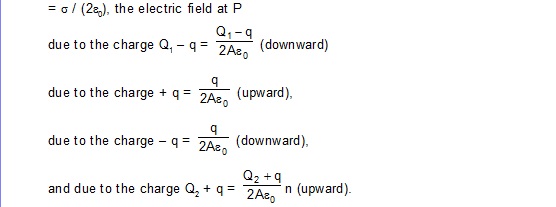
The net electric field at P due to all the four charged surfaces is (in the downward direction)
(C) The electric field calculated by Gauss’s law is the field due to the charges inside the Gaussian surface
(D*) The flux of the electric field through a closed surface due to all the charge is equal to the flux due to the charges enclosed by the surface.
2. A positive point charge Q is brought near an isolated metal cube.
(A) The cube becomes negatively charged
(B) The cube becomes positively charged
(C) The interior becomes positively charged and the surface becomes negatively charged.
(D*) The interior becomes remains charged free and the surface gets nonuniform charge
distribution.
3. A large nonconducting sheet M is given a uniform charge density. Two uncharged small metal rods A and B are placed near the sheet as shown in fig.
(A*) M attracts A (B*) M attracts B (C*) A attracts B (D*) B attracts A
4. If flux of the electric field through a closed surface is zero,
(A) the electric field must be zero everywhere on the surface
(B*) the electric field may be zero everywhere in the surface
(C*) the charge inside the surface must be zero
(D) the charge in the vicinity of the surface must be zero.
5. An electric dipole is placed at the cnetre of a sphere, Mark the correct options.
(A*) The flux of the electric filed through the sphere is zero
(B) The electric field is zero at every point of the sphere
(C*) The electic field is not zero anywhere on the sphere
(D) The electric field is zero on a circle on the sphere.
6. Figure (30-Q5) shows a charge q placed at the centre of a hemisphere. A second charge Q is placed at one of the positions A, B, C and D.
In which position(s) of this second charge, the flux of the electric field through the hemisphere remains unchanged ?
(A*) A (B) B (C*) C (D) D
7. A closed surface S is constructed around a conducting wire connected to a battery and a switch (fig.) As the switch is closed,
the free electrons in the wire start moving along the wire. In any time interval, the number of electrons entering the closed
surface S is equal to the number of electorns leaving it. On closing the switch, the flux of the electric field through the closed surface.
(A) is increased (B) is decreased (C*) remains unchanged (D*) remains zero
8. Fig. shows a closed surface which intersects a conducting sphere. If a positive charged is placed at the point P, the flux of the electic
field through the closed surface
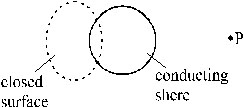
(A) will remain zero (B) will become positive (C) will become neagative (D) will become undefined
Exercise

2. A charge Q is uniformy distributed over a rod of length l. Consider a hypothetical cube of edge l with the centre
of the cube at one end of the rod. Find the minimum possible flux of the electric field through the entire surface of the cube.
[Ans. Q/(ee0)]
3. Show that there can be no net charge in a region in which the electric field is uniform at all points.
![]()
bounded by the surface x = 0, x = a, y = 0, y = a, z = 0 and z = a. Take E0 = 5 × 103 N/C, l = 2 cm and a = 1 cm. [Ans. 2.2 × 10–12 C]
5. A charge Q is placed at the centre of a cube. Find the flux of the electric field through the six surfaces of the cube. [Ans. Q/e0]
6. A charge Q is placed at a distance a/2 above the centre of a horizontal, square surface of edge a as shown in figure.
Find the flux of the electric field through the square surface. [Ans. Q/(6e0)]

7. Find the flux of the electric field through a spherical surface of radius R due to a charge of 10–7C at the centre and
another equal charge at a point 2R away from the centre
[Ans. 1.1 × 104 N-m2/C ]
8. A charge Q is placed at the centre of an imaginary hemispherical surface. Using symmetry arguments and the
Gauss’s law, find the flux of the electric field due to this charge through the surface of the hemisphere
[Ans. Q/(2e0)]
9. A spherical volume contains a uniformly distributed charge of density 2.0 × 10–4 C/m3. Find the electric
field at a point inside the volume at a distance 4.0 cm from the centre.
[Ans. 3.0 × 105 N/C]
10. The radius of a gold nucleus (Z = 79) is about 7.0 × 10–15 m. Assume that the positive charge is distributed
uniformly throughout the nuclear volume. Find the strength of the electric field at (a) the surface of the nucleus and
(b) at the middle point of a radius. Remembering that gold is a conductor, is it justified to assume that the positive
charge is uniformly distributed over the entire volume of the nucleus and does not come to the outer surface? [Ans. (a) 2.32 × 1021 N/C (b) 1.16 × 1021 N/C]
11. A charge Q is distributed uniformly within the material of a hollow sphere of inner and outer radii r1 and r2 figure.
Find the electric field at a point P a distance x away from the centre for r1 < x < r2. Draw a

12. A charge Q is placed at the centre of an uncharged, hollow metallic sphere of radius a (a) Find the surface charge density
on the inner surface and on the outer surface. (b) If a charge q is put on the sphere, what would be the surface charge
densities on the inner and the outer surfaces? (c) Find the electric field inside the sphere at a distance x from the
centre in the situations (a) and (b).

13. Consider the following very rough modle of a beryllium atom. The nucleus has four protons and four neutrons
confined to a small volume of radius 10–15m. The two 1s electrons make a spherical charge cloud at an average
distance of 1.3 × 10–11 m from the necleus, whereas the two 2s electrons make another spherical cloud at an
average distance of 5.2 × 10–11 m from the nucleus. Find the electric field at (a) a point just inside the 1 s
cloud and (b) a point just inside the 2s cloud. [Ans. (a) 3.4 × 1013 N/C, (b) 1.1 × 1012 N/C]
14. Find the magnitude of the electric field at a point 4cm away from a line charge of density 2 × 10–6 C/m.
[Ans. 9 × 105 N/C]
15. A long cylindrical wire carries a positive charge of linear density 2.0 × 10–8 C/m. An electron revolves
around it in a circular path under the influence of the attractive electrostatic force. Find the kinetic energy
of the electron. Note that it is independent of the radius. [Ans. 2.88 × 10–17 J]
16. A long cylindrical volume contains a uniformly distributed charge of density r. Find the electric field
at a point P inside the cylindrical volume at a distance x from its axis figure. [Ans. rx/(2e0)]
17. A nonconducting sheet of large surface area and thickness d contains uniform charge distribution
of density r. Find the electric field at a point P inside the plate, at a distance x from the central plane.
Draw a qualitative graph of E against x for 0 < x < d. [Ans. px/e0]
18. A charged particle having a charge of –2.0 × 10–6 C is placed close to a nonconducting plate
having a surface charge density 4.0 × 10–6 C/m2. Find the force of attraction between the
particle and the plate. [Ans. 0.45 N]
19. One end of a 10cm long silk thread is fixed to a large vertical surface of a charged nonconducting
plate and the other end is fastened to a small ball having a mass of 10g and a charge of 4.0×10–6 C.
In equilibrium, the thread makes an angle of 60º with the vertical. Find the surface charge density on the plate. [Ans. 7.5 × 10–7 C/m2]
20. Consider the situation of the previous problem. (a) Find the tension in the string in equilibrium.
(b) Suppose the ball is slightly pushed aside and released. Find the time period of the small oscillations. [Ans. (a) 0.20 N (b) 0.45 s]
21. Two large conducting plates are placed parallel to each other with a separation of 2.00 cm between
them. An electron starting from rest near one of the plates reaches the other plate in 2.00 microseconds.
Find the surface charge density on the inner surfaces. [Ans. 0.505 × 10–12 C/m2]
22. Two large conducting plates are placed parallel to each other and they carry equal and opposite
charges with surface density s as shown in figure. Find the electric field (a) at the left of the plates ,
(b) in between the plates and (c) at the right of the plates. [Ans. (a) zero (b) s/e0 (c) zero]
23. Two conducting plates X and Y, each having large surface area A (on one side), are placed
parallel to each other as shown in figure. The plate X is given a charge Q whereas the other is neutral.
Find (a) the surface charge density at the inner surface of the plate X, (b) the electric field at a point to the left of the plates,
(c) the electric field at a point in between the plates and (d) the electric field at a point to the right of the plates.

![]()
24. Three identical metal plates with large surface areas are kept parallel to each other as shown in figure.
The leftmost plate is given a charge Q, the rightmost a charge – 2Q and the middle one remains neutral.
Find the charge appearing on the outer surface of the rightmost plate.

[Ans. –Q/2]